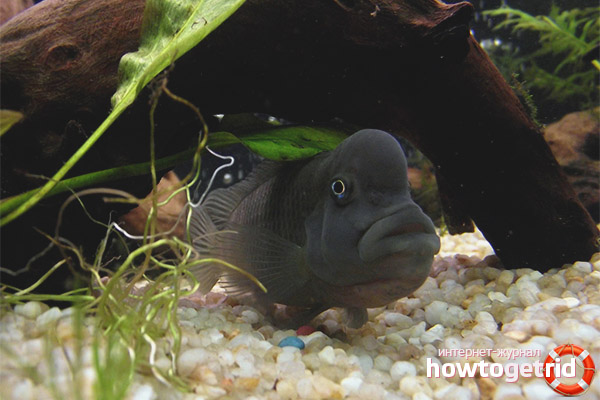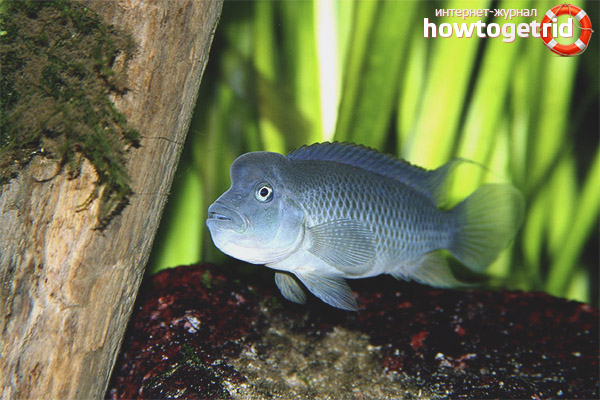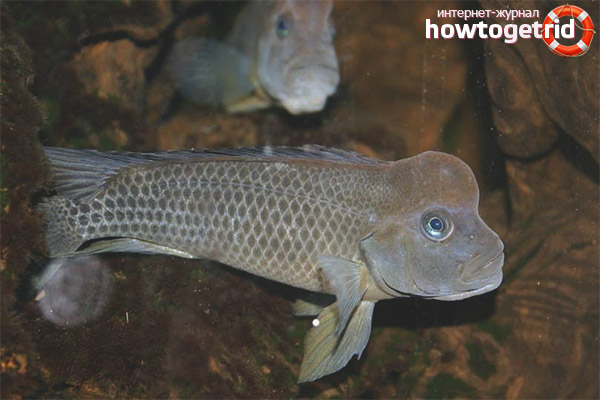The content of the article
The Latin name for the lion-headed cichlid is Steatocranus casuarius. The fish has such a name due to the fact that males of this species have a cone on their heads. Today, there are many species of fish with a similar appearance, but recently such a lump has been rare.
general characteristics
Another interesting difference between the lion-headed cichlids is that they swim in a special way. They do not just swim, but move in jerks, each time leaning on the bottom of a reservoir or aquarium. This feature is due to the fact that these fish live in water bodies, in which the current is quite strong. They move, leaning on the fin. Their swim bladder is smaller. This allows you to increase the weight of the fish in the water, and also gives it the opportunity to withstand the flow.
Compared with other representatives of cichlids, lion-headed representatives are small. Individuals grow to 11 cm. This allows the species to be kept even in relatively small aquariums.
Water hardness and pH do not play a big role for them. But it is important that the water is always very clean, it should contain enough oxygen. After all, these fish are used to just such water.
These cichlids are quite livable. They can coexist with small fish that also prefer fast waters. These fish find a mate to stay together. Therefore, if one of the partners dies, then the second fish is difficult to create a couple again. They often do not want to spawn with other individuals. The lion-headed cichlid can be attributed to territorial fish. This is especially evident during spawning.
Living in nature
Description
These fish have an elongated body. Their head is quite large. The eyes of a lion-headed cichlid are blue. A distinctive feature of males of this species is the presence of a cone on the head, consisting of adipose tissue. During the life of the fish, it increases in size. Fish have a green color. There are brown, gray, as well as blue blotches. Today you can meet a representative of a species that has a dark blue color. The male on average has a length of 11 cm, while the female is 3 cm less. Sometimes lion-headed cichlids can grow up to 15 cm in length.
How to feed
In the wild, these fish usually feed on benthos and some insects. When the aquarium content of representatives of this species is recommended to feed frozen feed. You can buy special foods that are designed for cichlids.
These fish are omnivorous. Therefore, when feeding them there should not be any special problems.
Content

It is advisable that the aquarium in which you will contain lion-headed cichlids have a volume of at least 80 liters. The bottom of the aquarium should be siphoned. It is better to change the water as often as possible. In addition, it is important to ensure that there is no ammonia and various nitrates in the water. Indeed, in nature, these fish are used to living in fairly clear water. The composition of the water in this case is not very important. But these cichlids are very fond of having a lot of oxygen in the water. An external filter must be powerful.The most comfortable these fish will feel in the water with a strong current. Indeed, it is precisely such an environment that is most familiar to them.
If you want to plant algae in the aquarium, it is better to plant them in pots. These fish can actively dig in the ground, causing plants to suffer. These cichlids love to remodel the soil as they wish.
When arranging the aquarium, it is necessary to provide these fish with as many shelters as possible. They love to hide. It is desirable that the temperature of the water when their content is in the range of 23-28 degrees.
Compatibility
Lion-headed cichlids can live in the same aquarium with different species. But it is important that there are no territorial differences between them. It is better if the neighbors of these cichlids are fish that live in the upper or middle layer. Neighbors should not be too small. Other fish related to cichlids are a good option. Those that are small are suitable. It can be meek or black-striped. But, the more fish you settle, the larger the volume should be.
Gender differences
This is one of those types of fish where sex is easy to determine. Females are smaller. If the fish has a characteristic bump on its head, then it is 100% male.
Breeding
Lion-headed cichlids choose a mate that remains very faithful. Most often, these fish do not change partners throughout their lives. If one of them dies, the second is unlikely to create a new pair. When the fish reaches a length of 6-7 cm - it embarks on the path of puberty. In order for the fish to choose a pair for themselves, you need to buy from 8 to 10 fry so that they grow together.
It is difficult to observe the spawning process, as the fish hide in various shelters. Under a stone or other decorative element in the aquarium, a couple makes a hole for themselves. Eggs are delayed 20-60 at a time. 7 days after this, a larva appears. After another week, the male will be able to swim independently. Parents of fry for a long time take care of them. Care lasts so long until the next spawning period sets in.
They protect their fry from the encroachment of strangers, and even rub the food if it turns out to be too large for the cub.
Fry content
When the fry have grown up and become independent, it is necessary to carefully monitor the male. He can become aggressive towards the female due to the fact that he feels the desire to spawn again. If you notice this behavior of the male, you need to temporarily put him off.
You can feed the fry with a special feed. In this regard, they are quite unpretentious, therefore, they may well eat nauplii, artemia, etc. You can give them granules and flakes. It is important to ensure that the feed settles to the bottom of the aquarium. Subject to the conditions of detention, as well as ensuring good nutrition, fry will grow rapidly.
Video: Lion-headed cichlid (Steatocranus casuarius)











Submit